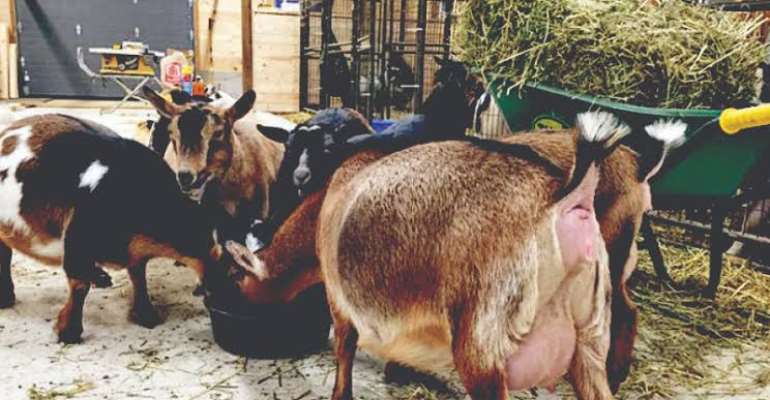Harnessing The West African Dwarf Goats (wad) Population For Milk Production

Recently, i was a guest of an effervescent sexagenarian who is an ex-banker with an obsessive passion for farming. His entrepreneurial adrenaline still keeps gushing like a broken pipe. What started as a hobby has morphed into a full-time profession. He is now flirting with the idea of incorporating a goat section into his growing farm. And the Boer breed reputed for its quality meat is high on list. This formed the kernel of our long conversation on goats.
At any rate, commercial goat farming is rapidly growing in Nigeria. For the most part, goats are raised under a mixed crop-livestock system by smallholder farmers on whose shoulders the nation’s food needs rest. It serves as source of income to many families. Goats are known primarily for meat. Other products simply pale in comparison, not least goat milk, which still sounds queer owing to its unpopularity. As a result, data or record hardly exists. However, goat farming the world over is a profitable venture whether for meat, milk or as pets.
Interesting, the Nigerian goat, according to reports is being sold at about 15,000 dollars in Australia as pets and for high quality milk where it is gaining popularity. Yes, you heard me right! The goat is strictly pure breed stock derived from improved genetics from the United States where the breed was developed and registered in the America breed herd book since the early 1980’s. And, as early as 2002 it got entry into the America dairy goat association herd book.
The Nigerian goat is derived from the popular West Africa dwarf goat (WAD). And, Nigeria is home to the largest population of the breed which is common in West and Central Africa. It landed in America as a source of feed for lions and other large cats in the zoo before gaining acceptance amongst the populace. So the population burgeoned as it underwent refinement by breeders who were enamoured of its exceptional qualities. The breed provides an average of 1.8 – 4 litres of milk with a butterfat that ranges an average of 6.5- 10%. The cheese produced is said to be of great quality.
Generally, Goats possesses milk with great butterfat - the natural fat confers a distinctive taste and aroma providing delicious milk and cheese as well as making the milk creamy. Prolific Diary goats in the developing countries especially in Europe are results of elaborate breeding programme. The genetic improvement has led to considerable increase in yield and longer lactation lengths.
The dairy goat sector is an important part of the global industry which encompasses cow, buffalo, Carmel milk and their products. And, it’s staging serious challenges to the traditional milk sources. There’s a global uptick in goat population mainly due to growing demand. Asia remains the capital of the world’s dairy goat production and consumption.
India is reputed as the largest milk producer with annual production of over 5 million metric tonnes. France is described as the European benchmark both in milk and pure goat cheese making. Others like Spain, Netherlands are strong players. This also includes Mexico in America with many other countries scattered across the globe.
The conflation of surging demand strong prices and climate change is leading the growth of dairy goat industry in countries that are not traditional goat milk producers like China where the Shaanxi province has developed into the biggest dairy goat hub. Goat milk and products are increasingly sought after due to their health and nutritional benefits, greater digestibility and lipid metabolism. Interestingly, Mahatma Gandhi was a high-profile consumer of goat milk. When he was arrested in May 5, 1930, it was reported that the British government paraded before reporters “a dozen woolly animals of the purest strain purchased by His Majesty’s government to supply the prisoner with his favourite beverage- goat’s milk. His daily requirement of goat milk is met in whatever part of the globe he travels to.
Nigeria needs to leverage on its large population of WAD for milk production. Already a huge appetite for milk exist which is instantiated by the large milk import and the resultant huge financial heft on the nation falling foreign exchange. In light of this, a backward integration strategy was introduced to fuel local production with a glimmer of hope emerging from the Promasidor and Ekiti state Ikun Dairy farm partnership.
So, developing dairy goat industry can play a contributory part in satisfying the local demand. It’s no doubt a challenging undertaking especially building from ground zero. In achieving the goal a standalone policy for the sector is of consequence; with great effort targeted at elaborate breeding and genetic improvement of goats and developing dairy goat product market etc. This will take considerable willpower on the part of government. The blip in the upgrade of our local cows for improved milk and the dairy industry in general speaks to the poor commitment of authorities. By and large, commitment should drive the aspiration for a vibrant dairy goat industry.
Abachi Ungbo [email protected]
